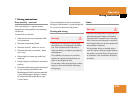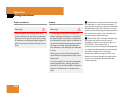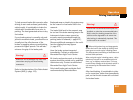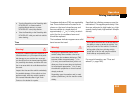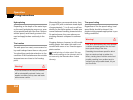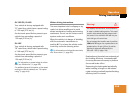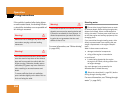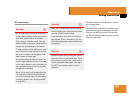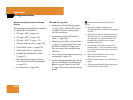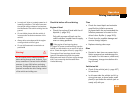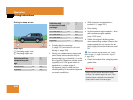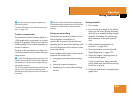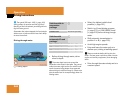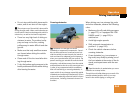
356
Operation
Driving instructions
If the vehicle is parked after being driven
on salt-treated roads, the braking efficien-
cy should be tested as soon as possible af-
ter driving is resumed.
For more information, see “Winter driving”
(
୴ page 420).
Standing water
For more information, see “Driving through
water” (
୴ page 362).
Warning! G
Make sure not to endanger any other road
users when carrying out these braking
maneuvers.
Warning! G
If the vehicle becomes stuck in snow, make
sure that snow is kept clear of the exhaust
pipe and from around the vehicle with the
engine running. Otherwise, deadly carbon
monoxide (CO) gases may enter vehicle in-
terior resulting in unconsciousness and
death.
To assure sufficient fresh air ventilation,
open a window slightly on the side of the ve-
hicle not facing the wind.
Warning! G
The outside temperature indicator is not de-
signed to serve as an ice-warning device and
is therefore unsuitable for that purpose. In-
dicated temperatures just above the freez-
ing point do not guarantee that the road
surface is free of ice.
!
Do not drive through flooded areas or water
of unknown depth. Before driving through water,
determine its depth. Never accelerate before
driving into water. The bow wave could force wa-
ter into the engine and auxiliary equipment, thus
damaging them.
If you must drive through standing water, drive
slowly to prevent water from entering the pas-
senger compartment or the engine compart-
ment.
Water in these areas could cause
ț damage to electrical components
ț wiring of the engine or transmission
or could result
ț in water being ingested by the engine
through the air intake, causing severe inter-
nal engine damage.
Any such damage is not covered by the
Mercedes-Benz Limited Warranty.
i
Select the raised level (୴ page 281) before
driving through standing water.




